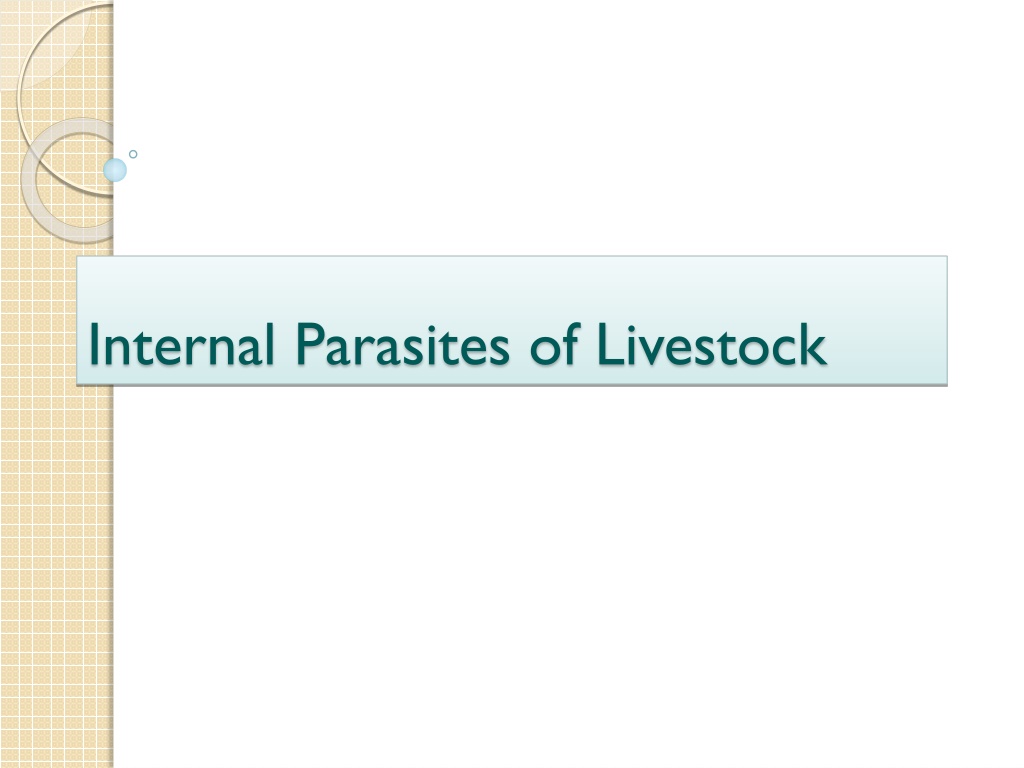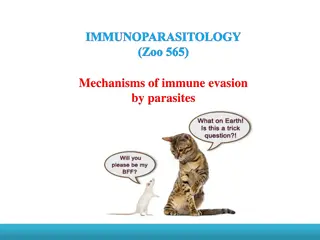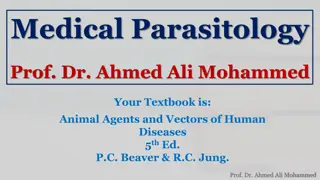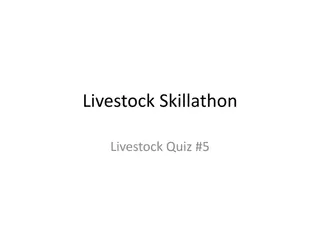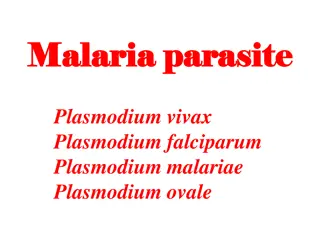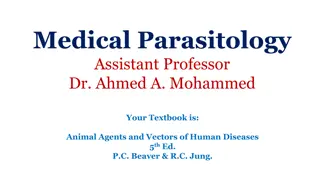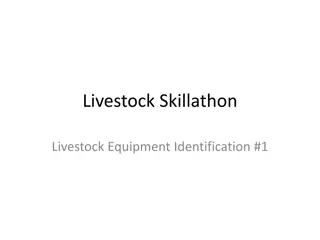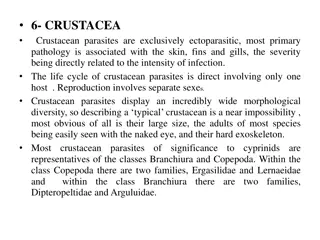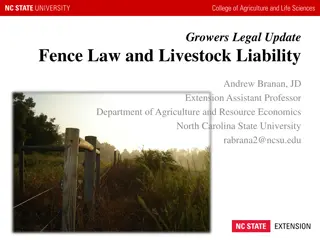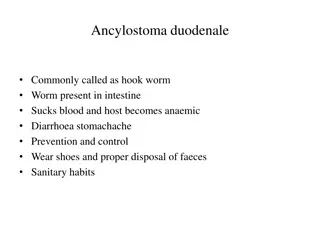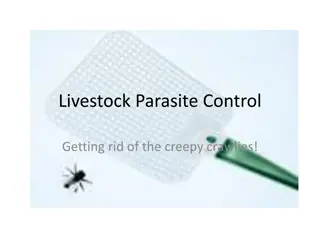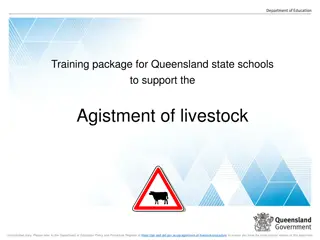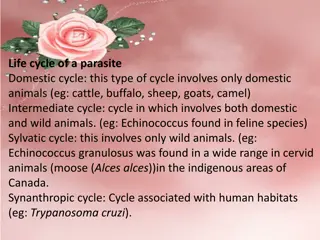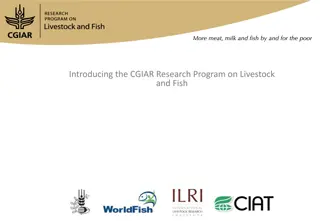Understanding Internal Parasites of Livestock
Internal parasites of livestock, such as roundworms, tapeworms, and flukes, can have a significant impact on the health and productivity of animals. These parasites live within the internal organs of livestock, causing various symptoms and affecting different species. Roundworms, like stomach worms, strongyles, and ascarids, are particularly common and damaging. Understanding their life cycles, hosts, and effects is crucial for effective management and prevention to maintain the well-being of livestock.
Download Presentation

Please find below an Image/Link to download the presentation.
The content on the website is provided AS IS for your information and personal use only. It may not be sold, licensed, or shared on other websites without obtaining consent from the author. Download presentation by click this link. If you encounter any issues during the download, it is possible that the publisher has removed the file from their server.
E N D
Presentation Transcript
Internal Parasites of Livestock Internal Parasites: live within the internal organs of livestock They are not visible Effects on the host may be visible Divided into three groups Roundworms Tapeworms Flukes
Roundworms Most important from economic standpoint Many different types Affect almost every type of livestock
Stomach Worms (Roundworm) Host: Every species of livestock Life Cycle: Adults live in stomach wall. Eggs pass from host and hatch into larvae Larvae are eaten by animal and travel to stomach where they mature.
Stomach Worms (Roundworm) Damage: Penetrate stomach lining Reduce digestion of nutrients Young undernourished animals are hit the hardest Symptoms Anemia- paleness of gums and white of eyes Dull hair coat Scours Severe infestation can cause weight loss and death
Strongyles (Roundworm) Host: All species of livestock Cattle & horse can build up immunity by ages 4 or 5 Life Cycle: Adult is attached to lining of intestines Eggs pass from host Larvae attach to grass and are eaten by animal Pass through stomach and attach to intestinal wall
Strongyles (Roundworm) Damage: Most detrimental Anemia Scar tissue reduces digestion of nutrients Major cause of Colic in horses Poor feed conversion Symptoms Anemia Weight Loss Scouring Loss of appetite Prostration Rough hair coat
Ascarids (Roundworm) Largest of round worms Can reach 8 to 15 inches in length Mainly affects younger animals Host: primarily cattle, sheep, hogs, and horses
Ascarids (Roundworm) Life Cycle: Eggs passed in feces contaminate pastures Animals ingest Larvae burrow into wall of intestine Migrate to liver, heart, and lungs Animal coughs up eggs and are swallowed Reach intestines a 2nd time and develop into adult stage
Ascarids (Roundworms) Damage: Develop pneumonia Weight loss Lung damage Colic in horses Symptoms Weight loss Dull hair coat Colic
Pinworms (Roundworms) Small and found in colon or rectum of horses Host: mainly horses, but can be found in other livestock species.
Pinworms (Roundworms) Life cycle: Adult females lay eggs around the anus of horse Eggs drop off and contaminate pastures, stables, watering and feeding area Eggs are ingested by animal Pass to colon and rectum and mature
Pinworms (Roundworms) Damage: Minor damage is caused Cause irritation around the tail Symptoms: Tail rubbing White scales deposits are visible around anus
Habronema (Roundworm) Affects host in two stages Host: Horse is major host House fly is intermediate host
Habronema (Roundworm) Life Cycle: Adult stage is found in stomach Larvae is passed which is ingested by house fly House fly deposits eggs on lips of horse Horse swallows eggs and they mature in horses stomach
Habronema (Roundworm) Damage: Summer sores can form if larvae are deposited in open wounds Disfigure horses Hard to heal Symptoms: Presence of summer sores Excessive tearing and running of eyes Open sores
Lungworms (Roundworms) Affect circulatory system & lungs Host: All species of livestock
Lungworms (Roundworms) Life Cycle: Eggs laid in lungs of animals Coughed up & swallowed Eggs hatch in stomach and larvae are passed Develop in moist earth or water Ingested by animal Burrow into lymph nodes and are carried to lungs where they mature
Lungworms (Roundworms) Damage: Mechanical blockage of lungs Collapse of infected area Blockage of windpipe and bronchea Symptoms: Coughing Fast or forceful breathing Fever Animal reluctant to move Goes off of feed and water
Tapeworms Less important than roundworms 3 species of tapeworms Broad tapeworm Beef tapeworm Pork tapeworm
Broad Tapeworm Life Cycle: Adult lives in small intestine Segments containing eggs break off and pass out of animal Eggs are eaten by oribated mite Mites are eaten by host and eggs hatch in small intestine Host: All classes of livestock and also in man Reach up to 10 feet in length
Broad Tapeworm Damage: No physical damage Tapeworm is in competition with animal for food. Symptoms Weight loss Diarrhea emaciation
Beef and Pork Tapeworm Both are similar and almost identical Host: Beef tapeworm- cattle and man Pork tapeworm- swine and man Man is necessary intermediate host Reach 5 feet in length
Beef and Pork Tapeworm Life Cycle: Adult lives only in man Eggs contaminate the feed of animal through human contact Animal ingests feed and eggs pass to intestinal wall Larvae lodge in some muscle causing a cyst Passed back to man when infected meat is eaten
Beef and Pork Tapeworm Damage: Little economic damage to cattle Causes mealy beef Symptoms: No visible symptoms except when animal is slaughtered
Flukes Several species Liver Fluke is the most important
Liver Fluke Host: Parasite of cattle, sheep, goats, and man Damaging to young animals
Liver Fluke Life Cycle: Adult lives in bile ducts Eggs passed into intestines and passed out Eggs must be in water to hatch Larvae hatch and seek a snail Larvae develops on snail and then attaches to a plant Animals ingest infected plant Flukes pass to intestines and burrow through abdominal cavity to the lungs.
Liver Flukes Damage: Irritation and thickening of bile duct Fibrosis of the liver Symptoms: Anemia Weight loss Death if not treated.
Tomorrow We will go over control methods of internal parasites.
